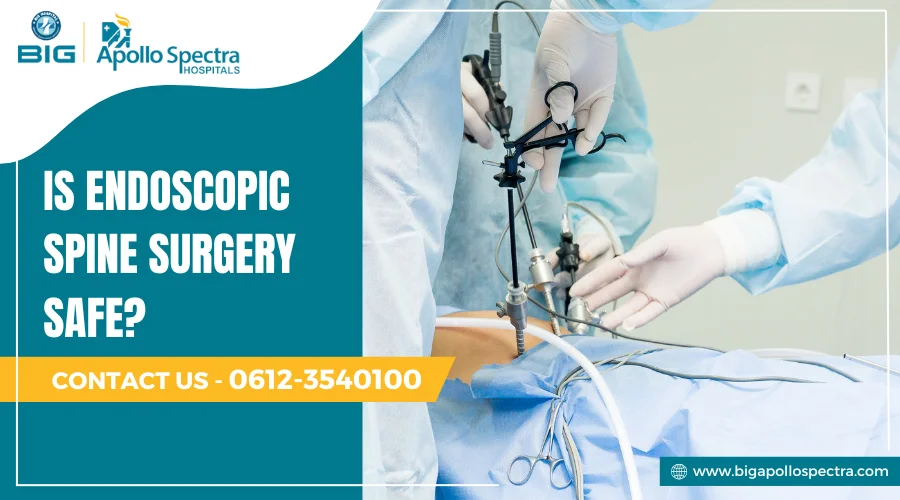Spinal problems can turn everyday tasks into seemingly impossible challenges. Endoscopic spine surgery represents a revolutionary medical intervention that transforms the approach to spinal treatment.
Traditional surgical methods require major incisions and extensive tissue disruption while this minimally invasive procedure provides new hope for patients who cope with chronic back pain and spinal disorders. This surgical method represents efficient and precision based operations with a much faster recovery time than traditional operations.
However, the ongoing evolution of medical technology has prompted patients to show more interest in understanding more about the safety of this innovative medical treatment.
This in-depth analysis will investigate endoscopic spine surgery by evaluating its safety records and potential advantages while reviewing the scientific proof behind its expanding role in medical practice today.
Is Endoscopic Spine Surgery Safe?
The safety profile of endoscopic spine surgery has been positive according to medical statistics. In fact, recent scientific investigations have produced powerful evidence supporting its effectiveness.
Data from research shows endoscopic spine surgery success rate in India to be between 80-90% for diverse spinal conditions. Multiple clinical studies reveal low complication rates of 2-5% which remain substantially below complication rates of traditional open surgery.
Research published in peer-reviewed journals shows that patients experience lower infection risks and minimal blood loss with faster recovery periods when they opt for endoscopic spine surgery.
A landmark research published in the International Journal of Spine Surgery revealed that patients who received endoscopic surgery experienced less postoperative complications. This demonstrates real-world results which provide genuine hope for patients needing relief from debilitating spinal disorders.
Here’s a short comparative review of traditional and endoscopic surgery for spinal issues to demonstrate how these two differ.
Traditional vs. Endoscopic Spine Surgery: A Comparative Lens
Traditional or open spine surgery functions involve making large incisions that might lead to substantial tissue damage along with prolonged recovery times.
Endoscopic spine surgery, on the other hand, functions like a precise digital medical procedure. The key differences are actually significant when these two are compared on the basis of different parameters:
1. Incision Size
Traditional spine surgery requires large 4-6 inch incisions whereas endoscopic techniques use small 1-2 cm openings.
2. Tissue Damage
Traditional spine surgery may lead to extensive muscle and tissue disruption while endoscopic spine surgery results in minimal tissue interference.
3. Recovery Time
Patients who undergo traditional spinal surgical procedures require about 12 weeks for recovery while those who undergo endoscopic procedures typically recover within 2-4 weeks.
4. Need for Hospital Stay
Traditional surgery hospital stays require 3-5 days but endoscopic procedures usually allow patients to leave on the same day or by the next morning.
5. Scarring
Traditional surgery produces noticeable scars while endoscopic surgery results in nearly invisible incisions.
Hence, most patients today would consider endoscopic surgery to be much more practical and advanced when compared to traditional approaches.
If you also want to inquire about the best surgical procedure for you, always get help from someone who specializes in the subject. Those residing in Patna can consult a top rated orthopedic doctor in Patna for spinal issues to get rid of any persistent symptoms and discomfort.
Endoscopic Spine Surgery Benefits
Endoscopic spine surgery offers remarkable advantages including:
- Minimal muscle and tissue disruption
- Significantly reduced endoscopic spine surgery recovery time
- Lower risk of post-surgical complications
- Faster return to normal activities
- Reduced pain and discomfort in the procedure
- Smaller cosmetic impact with minimal scarring an smaller incision
- Precision-guided surgical approach
Also, when it comes to endoscopic spine surgery cost, it also proves to be less expensive than traditional surgical methods.
Patients frequently describe endoscopic spine surgery as a life-changing experience. That’s mainly because the psychological benefits of undergoing a less invasive procedure carry significant weight for most patients.
Patients can walk into the hospital and expect to return home on the same day without major interruptions to their daily lives, making this modern surgical procedure much sought after.
Additionally, most patients experience reduced anxiety when undergoing these endoscopic spine surgeries compared to standard spinal operations.
Due to a faster recovery time, it’s also easier to experience a greater sense of control during their recovery process because they no longer face the fear of prolonged hospital stays and extended healing times.
Thus, this minimally invasive procedure promotes faster physical healing while offering substantial emotional and mental comfort. While we are discussing the many benefits of endoscopic spine surgery, it’s also imperative to know about the possible downsides.
Potential Risks of Endoscopic Spine Surgery
While an innovative surgical method, the procedure isn’t without potential side effects that may include:
- Rare instances of nerve damage
- Potential surgical site infections
- Minor bleeding
- Temporary numbness or weakness
- Potential for unsuccessful symptom resolution
- Anesthesia-related complications
- Minimal risk of cerebrospinal fluid leakage
NOTE: These risks should be understood as existing at levels that remain lower than those associated with traditional surgical procedures.
Well, spine surgery remains inherently complicated meaning every procedure has some level of risk involved. Several factors including the patient’s health status, age and specific spinal condition together with the surgeon’s proficiency may determine the likelihood of complications.
Moreover, it’s always a possibility that a few patients will encounter temporary side effects which disappear over a period of weeks to months. To minimize the risks, think about investing in a pre-surgical screening together with a thorough health evaluation and select an experienced and skilled orthopaedic.
Effective communication with your healthcare provider regarding your medical history and current health status also helps prevent potential complications.
Technological Advancements: Making Surgery Safer
The safety landscape of endoscopic spine surgery has been revolutionized by recent technological advancements. Real-time 3D navigation systems enable surgeons to achieve unparalleled precision through advanced imaging techniques.
AI-assisted endoscopic surgery for spinal stenosis has transformed treatment methods by significantly minimizing human mistakes.
Moreover, advanced microscopic camera technologies now deliver surgeons precise and magnified images of the surgical site with exceptional clarity. Enhancement in the maneuverability of surgical instruments allows complex operations through very small cuts, reducing patient risk while improving surgical success rates.
Much of the success of spinal surgical procedures depends on the orthopaedic surgeon. Thus, it’s stressed to take time when deciding about the surgery before jumping to conclusions.
Big Apollo Spectra Hospital – Your Path to Recovery
The exploration of the safety risks of endoscopic spine surgery reveals some interesting facts with an optimistic outcome. The evidence reveals that this surgical method provides a safer and more effective option when compared to standard spine surgeries despite some inherent surgical risks.
Almost any surgical procedure comes with a certain degree of risk which is unavoidable in cases where surgery is necessary. Still, endoscopic spine surgery turns out to be a much less invasive surgical treatment than traditional surgeries.
When seeking quality treatment, Big Apollo Spectra is the best orthopedic hospital in Patna that provides patients with excellent care through its advanced facilities and a team of highly-rated and qualified orthopedic doctors.
It is essential to seek advice from seasoned medical experts while understanding your condition and setting achievable expectations. The treatment path should be determined through personalized medical advice because each patient has a unique journey.
Moreover, always remember to use this article as general guidance, and it should not take the place of professional medical advice. A qualified healthcare provider at Big Apollo Spectra should be consulted for advice on your specific medical condition.





